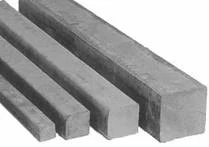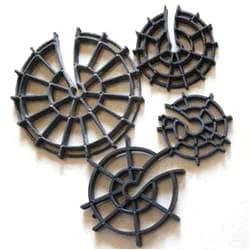Cover blocks (spacer blocks) are broadly divided into two main types based on the materials used in the manufacturing process.
They are,
A. Concrete cover blocks &
B. PVC cover blocks.
Both types of cover blocks ( Fig. 1.) are ideal for RCC structures, but I prefer concrete blocks (in my opinion) over PVC cover blocks.
The concrete covers needed for the rebars in the different RCC structures depend upon the rebar diameter, type of structure, environmental conditions, and direction of the rebars (longitudinal or transverse). So, to fill up all the specific needs, cover blocks come in various shapes and sizes with different dimensions.
Now let us see the different types of cover blocks which come under each one of them.
They are the simple and basic type of spacers with a cover dimension of any one size. They can be used for a single type of RCC structure with specific cover distances.
A. Concrete cover blocks &
B. PVC cover blocks.
Both types of cover blocks ( Fig. 1.) are ideal for RCC structures, but I prefer concrete blocks (in my opinion) over PVC cover blocks.
The concrete covers needed for the rebars in the different RCC structures depend upon the rebar diameter, type of structure, environmental conditions, and direction of the rebars (longitudinal or transverse). So, to fill up all the specific needs, cover blocks come in various shapes and sizes with different dimensions.
Now let us see the different types of cover blocks which come under each one of them.
A. Concrete cover blocks:
1. Single cover spacers:
They are the simple and basic type of spacers with a cover dimension of any one size. They can be used for a single type of RCC structure with specific cover distances.
If 15mm cover blocks are manufactured for providing cover to the slabs, then you have to use them for slabs that need a 15mm cover only.
Fig 2. (given below ) shows a single cover spacer for the slabs.
These types of spacers contain many sizes in a single piece. They may contain 2 or more sizes that can be used for different RCC members to provide the concrete covers specified for each one of them.
 |
| Single cover spacer Fig. 2. |
2. Multiple cover spacers:
These types of spacers contain many sizes in a single piece. They may contain 2 or more sizes that can be used for different RCC members to provide the concrete covers specified for each one of them.
Fig. 3. shows a multiple cover spacer with 20mm and 25mm sizes which can be used for slabs or beams of various sizes.
These types of spacers are circular in shape with a hole in the center or with multiple openings for the insertion of rebars, which needs concrete covering. They are the ideal type of spacers for columns of different dimensions.
 |
| Multiple cover spacer Fig 3. |
3. Circular spacers:
These types of spacers are circular in shape with a hole in the center or with multiple openings for the insertion of rebars, which needs concrete covering. They are the ideal type of spacers for columns of different dimensions.
Fig. 4. shows the sample of a circular spacer with a single opening.
These type of spacers find their use in heavy-duty infrastructures like tunnels, bridges, retaining walls, etc. where the rebar dia. is much more, with close spacing between the two bars. They may be of any shape like rectangular, circular, or with some curves according to their requirements.
 |
| Circular spacer Fig 4. |
4. Bar spacers:
These type of spacers find their use in heavy-duty infrastructures like tunnels, bridges, retaining walls, etc. where the rebar dia. is much more, with close spacing between the two bars. They may be of any shape like rectangular, circular, or with some curves according to their requirements.
Fig 5. shows the bar spacer of rectangular size.
They have clips to hold the bars of different diameters in a firm position to maintain their distance with accuracy.
 |
| Bar spacers Fig. 5. |
5. Clip spacers:
They have clips to hold the bars of different diameters in a firm position to maintain their distance with accuracy.
Fig 6 shows one of such spacers for your reference.
The advantage of such a type of spacer is, you can fix and lock it externally after the completion of reinforcement work for the columns. It gives the same cover distance even if the column rebars get twisted.
These are the circular spacers with the rebar embedding space at the center, where rebar can be slipped in from the one-side openings.
 |
| Spacer with the clip Fig. 6. |
6. Circular spacer with lock pin:
The advantage of such a type of spacer is, you can fix and lock it externally after the completion of reinforcement work for the columns. It gives the same cover distance even if the column rebars get twisted.
B. PVC cover blocks:
1. Wheel spacer.
These are the circular spacers with the rebar embedding space at the center, where rebar can be slipped in from the one-side openings.
The wheel spacer is shown in fig. 7.
As the name suggests, it looks like a chair over which rebar can sit comfortably within the hooks. They are available in different shapes with the needed dimensions.
 |
| p.v.c. wheel spacer Fig. 7. |
2. Chair spacer.
As the name suggests, it looks like a chair over which rebar can sit comfortably within the hooks. They are available in different shapes with the needed dimensions.
Fig. 8. shows one kind of chair spacer out of many.
They are continuous-type spacers, somewhat similar to the bar spacers, as mentioned above in the concrete spacers.
 |
| Chair spacer. Fig. 8. |
3. Linear spacer:
They are continuous-type spacers, somewhat similar to the bar spacers, as mentioned above in the concrete spacers.
To have an idea I have given the image of the linear spacer in fig. 9.
There are many other types of spacers, but I have not discussed them here, since they are rarely used in real applications.
To go through the articles related to the different types (classifications) of construction materials, click here.
 |
| Linear spacer Fig 9. |
There are many other types of spacers, but I have not discussed them here, since they are rarely used in real applications.
To go through the articles related to the different types (classifications) of construction materials, click here.













No comments:
Post a Comment